2013 Peugeot 508 fuel
[x] Cancel search: fuelPage 68 of 340
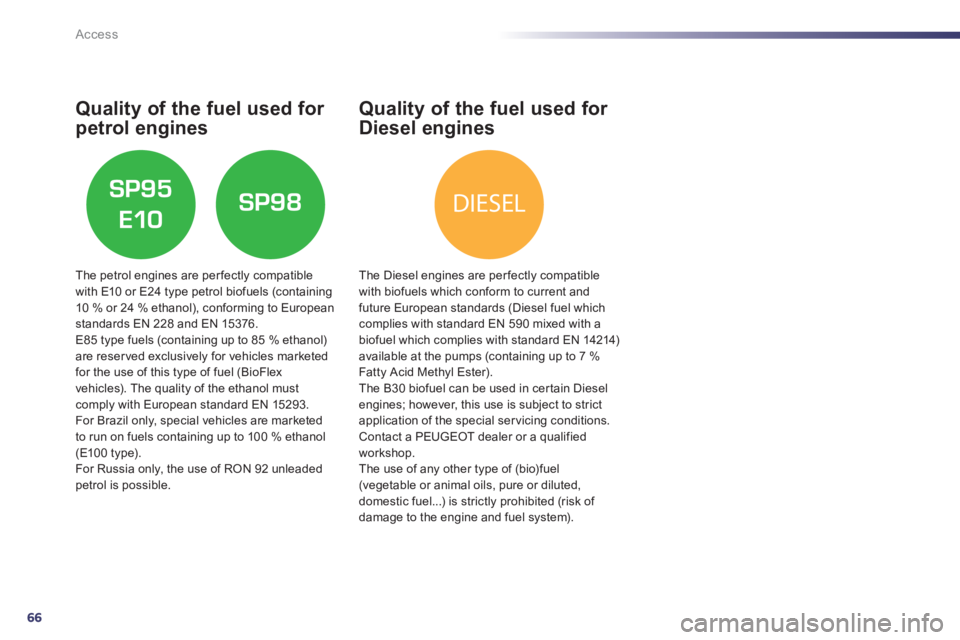
66
DIESEL
Access
Quality of the fuel used for
petrol engines
The petrol engines are perfectly compatible
with E10 or E24 type petrol biofuels (containing10 % or 24 % ethanol), conforming to Europeanstandards EN 228 and EN 15376.
E85 type fuels (containing up to 85 % ethanol) are reserved exclusively for vehicles marketed
for the use of this type of fuel (BioFlex
vehicles). The quality of the ethanol mustcomply with European standard EN 15293.For Brazil only, special vehicles are marketed
to run on fuels containing up to 100 % ethanol (E10 0 t y p e).
For Russia only, the use of RON 92 unleaded petrol is possible.
Quality of the fuel used for
Diesel engines
The Diesel engines are perfectly compatible
with biofuels which conform to current andfuture European standards (Diesel fuel whichcomplies with standard EN 590 mixed with abiofuel which complies with standard EN 14214)available at the pumps (containing up to 7 %Fatty Acid Methyl Ester).
The B30 biofuel can be used in cer tain Diesel engines; however, this use is subject to strict
application of the special ser vicing conditions.
Contact a PEUGEOT dealer or a qualified
workshop.
The use of any other type of (bio)fuel (vegetable or animal oils, pure or diluted,
domestic fuel...) is strictly prohibited (risk of
damage to the engine and fuel system).
Page 89 of 340
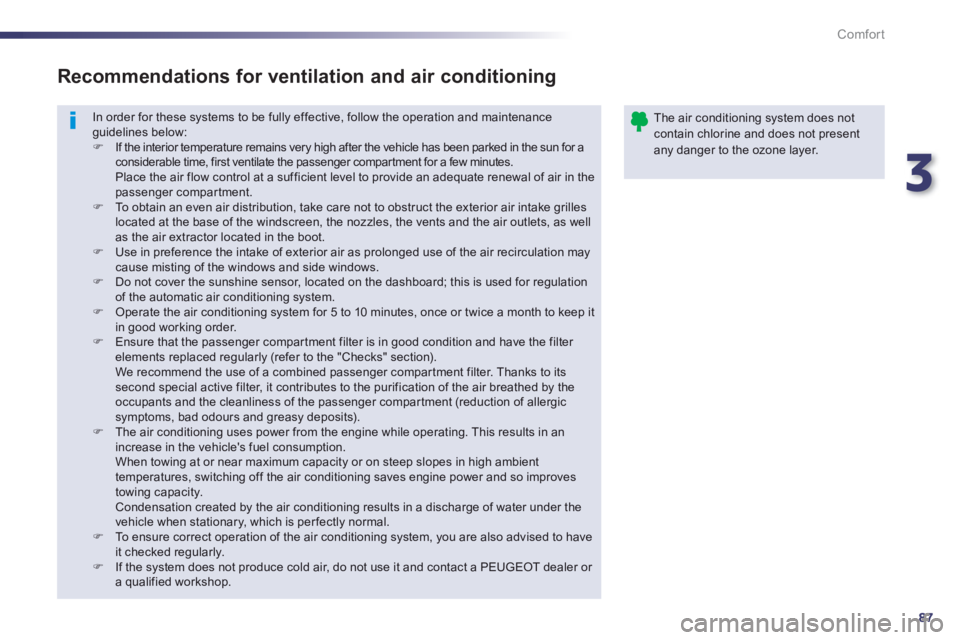
3
87
Comfort
In order for these systems to be fully effective, follow the operation and maintenance guidelines below: F
If the interior temperature remains very high after the vehicle has been parked in the sun for a considerable time, first ventilate the passenger compar tment for a few minutes. Place the air flow control at a sufficient level to provide an adequate renewal of air in the passenger compartment.F
To obtain an even air distribution, take care not to obstruct the exterior air intake grilles located at the base of the windscreen, the nozzles, the vents and the air outlets, as wellas the air extractor located in the boot. F
Use in preference the intake of exterior air as prolonged use of the air recirculation maycause misting of the windows and side windows.F
Do not cover the sunshine sensor, located on the dashboard; this is used for regulation of the automatic air conditioning system.F
Operate the air conditioning system for 5 to 10 minutes, once or twice a month to keep itin good working order. F
Ensure that the passenger compar tment filter is in good condition and have the filter elements replaced regularly (refer to the "Checks" section). We recommend the use of a combined passenger compartment filter. Thanks to its second special active filter, it contributes to the purification of the air breathed by the occupants and the cleanliness of the passenger compartment (reduction of allergic symptoms, bad odours and greasy deposits).F
The air conditioning uses power from the engine while operating. This results in anincrease in the vehicle's fuel consumption. When towing at or near maximum capacity or on steep slopes in high ambient temperatures, switching off the air conditioning saves engine power and so improvestowing capacity. Condensation created by the air conditioning results in a discharge of water under thevehicle when stationary, which is per fectly normal.F
To ensure correct operation of the air conditioning system, you are also advised to haveit checked regularly.F
If the system does not produce cold air, do not use it and contact a PEUGEOT dealer or a qualified workshop.
Recommendations for ventilation and air conditioning
The air conditioning system does notcontain chlorine and does not present any danger to the ozone layer.
Page 100 of 340

98
Comfort
F Switch off the demist/defrost of the rear screen and door mirrors assoon as it is no longer needed as lower current consumption results in reduced fuel consumption.
Front Demist -
Defrost
Rear screen demist -
defrost
The control button is located on theair conditioning system control panel.
With manual air
conditioning
F Select this programme to demistor defrost the windscreen and side windows as quickly aspossible.
With dual-zone and quad-
zone di
gital air conditioning
Automatic visibility programme
Switching on
F
Press this button to demist/defrost the rear screen and, depending on version, the door mirrors. The indicator lamp associated with
the button comes on.
With Stop & Star t, when demisting has been activated, the STOP mode is not available.
Switching off
The demist/defrost switches off automatically toprevent an excessive consumption of current. F
It is possible to stop the demist/defrost
operation before it is switched off automatically by pressing the button again.
The indicator lamp associated with the
button
goes off.
The system automatically manages the air conditioning, air flow and air intake, and provides optimum distribution towards the
windscreen and side windows.
Adjust the temperature control to quickly
demist /defrost the windows.
To switch it off, press the "visibility" button again, the warning lamp in the button goes off
and the system rever ts to the previous settings.
F Select this programme to demist or defrost the windscreen andside windows as quickly as possible.
The system automatically manages the air conditioning, air flow and air intake, and
provides optimum distribution towards the
w
indscreen and side windows.
With the quad-zone digital air conditioning,
pressing this button deactivates and locks the
rear air conditioning. F To stop the programme, press either the "visibility"button again or "AU TO "
, the
warning lamp on the button goes off and
the warning lamp in the "AU TO "buttoncomes on.
The system rever ts to the previous settings.
The rear screen demist - de
frost can onlyoperate when the engine is running.
Page 102 of 340
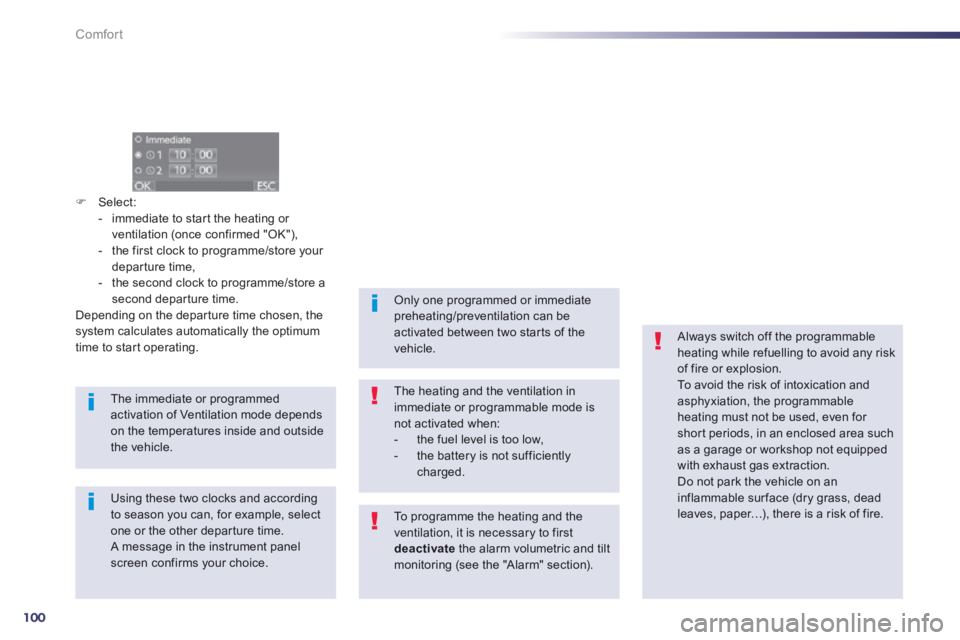
100
Comfort
FSelect:
- immediate to star t the heating or
ventilation (once confirmed "OK"),
- the first clock to programme/store your departure time,
- the second clock to programme/store a
second depar ture time.
Depending on the depar ture time chosen, the system calculates automatically the optimum
time to star t operating.
The immediate or programmedactivation of Ventilation mode depends on the temperatures inside and outsidethe vehicle.
Always switch off the programmableheating while refuelling to avoid any riskof fire or explosion.
To avoid the risk of intoxication andasphyxiation, the programmable heating must not be used, even for shor t periods, in an enclosed area such as a garage or workshop not equipped with exhaust gas extraction.
Do not park the vehicle on an inflammable surface (dry grass, dead leaves, paper
Page 114 of 340
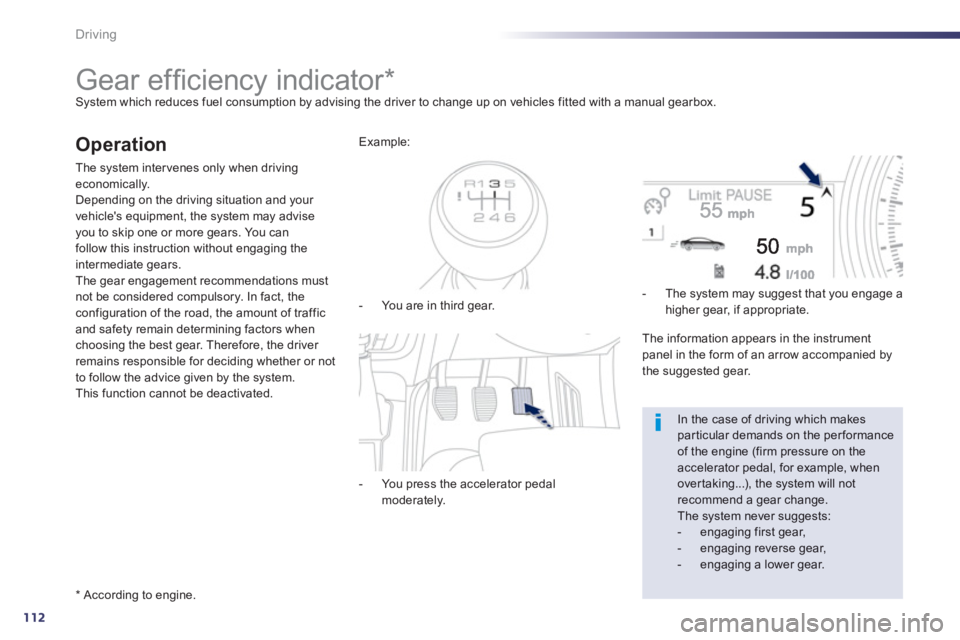
112
Driving
Gear effi ciency indicator * System which reduces fuel consumption by advising the driver to change up on vehicles fitted with a manual gearbox.
Operation
The system inter venes only when driving economically.
Depending on the driving situation and your
vehicle's equipment, the system may advise you to skip one or more gears. You can follow this instruction without engaging the intermediate gears.The gear engagement recommendations mustnot be considered compulsory. In fact, the configuration of the road, the amount of trafficand safety remain determining factors whenchoosing the best gear. Therefore, the driver remains responsible for deciding whether or not
to follow the advice given by the system.
This function cannot be deactivated.
*
Accordin
g to engine.
- You are in third
gear.
Exam
ple:
- You press the accelerator pedal
mo
derately.
- The s
ystem may suggest that you engage a higher gear, if appropriate.
The information appears in the instrument
panel in the form of an arrow accompanied bythe suggested gear.
In the case of driving which makespar ticular demands on the performance of the engine (firm pressure on theaccelerator pedal, for example, whenover taking...), the system will notrecommend a gear change. The system never suggests:
- engaging first gear,
- engaging reverse gear,
- engaging a lower gear.
Page 118 of 340

116
Driving
Manual operation
FSelect position M for sequentialchanging
of the six gears.FPull the lever towards the + sign to change
up a gear. FPush the lever towards the -
sign to change
down a gear.
It is only possible to change from one gear to another if the vehicle speed and engine speedpermit; otherwise, the gearbox will operate
temporarily in automatic mode.
D disappears and the gears engaged appear in succession in the
instrument panel.
Invalid value during manual operation
This symbol is displayed if a gear
is not engaged correctly (selector
between two positions).
Stopping the vehicle
Before switching off the engine, you can engage position P
or Nto place the gearbox in
neutral.
In both cases, apply the parking brake to
immobilise the vehicle, unless it is programmed
to automatic mode.
Operating fault
When the ignition is on, amessage appears in the
instrument panel screen to indicate a gearboxfault.
In this case, the gearbox switches to back-up mode and is locked in 3rd gear. You may feel
a substantial knock when changing from Pto Rand from N to R
. This will not cause any
damage to the gearbox.
Do not exceed 60 mph (10 0 km/h), local speed
restrictions permitting.
Have it checked by a PEUGEOT dealer or a qualified workshop.
If the en
gine speed is too low or too high, the gear selected flashes for a few seconds, then
the actual gear engaged is displayed.
It is possible to change from position D(automatic) to position M (manual) at any time.When the vehicle is stationary or movingvery slowly, the gearbox selects gear M1automatically.
The spor t and snow programmes do not
operate in manual mode.
You risk damaging the gearbox:
- if you press the accelerator and brake pedals at the same time,
- if you force the lever from position Pto another position when the batteryis flat.If the lever is not in position P
, when the Pdriver's door is opened or approximately 45 seconds after the ignition is switchedoff, there is an audible signal and a message appears. FReturn the lever to position P;the audible signal stops and themessage disappears.
To reduce fuel consumption when stationary for long periods with the engine running (traffic jam...), positionthe gear lever at Nand apply theparking brake, unless it is programmed in automatic mode.
Page 123 of 340

4
121
Driving
Stop & Start
The Stop & Star t system puts the engine temporarily into standby - STOP mode - during stops in the traffic (red lights, traffic jams, or other...).
The engine restar ts automatically - START mode - as soon as you want to move off. The restart takes place instantly, quickly and silently.
Per fect for urban use, the Stop & Star t system reduces fuel consumption and exhaust emissions as well as the noise level when stationary.
Operation
Going into engine STOP mode
The "ECO"warning lamp comes
on in the instrument panel and the
engine goes into standby:
-
with the electronic gearbox system, at speeds below 4 mph (6 km/h), press the brakepedal or put the gear lever in position N.
I
f your vehicle is fitted with the system, a timecounter calculates the sum of the periods in
STOP mode during a journey. It rests itself to
zero every time the ignition is switched on with
the ke
y.
Never refuel with the engine in STOPmode; you must switch off the ignition with the key.
For your comfort, during parking maoeuvres, STOP mode is not available for a few seconds after coming out of reverse gear. STOP mode does not affect the functionality of the vehicle, such as for example, braking, power steering...
Special cases: STOP mode notavailable
STOP mode is not invoked when:
- the driver's door is open,
- the driver's seat belt is not fastened,
- the vehicle has not exceeded 6 mph (10 km/h) since the last engine star t using
the key,
- the electric parking brake is applied or
being applied,
- the engine is needed to maintain acomfor table temperature in the passenger compartment,
- demisting is active,
- some special conditions (battery charge, engine temperature, braking assistance,
ambient temperature...) where the engine isneeded to assure control of a system.
In this case, the
"ECO"
warning lamp
flashes for a few seconds then goesoff.
This operation is per fectly normal
.
Page 220 of 340
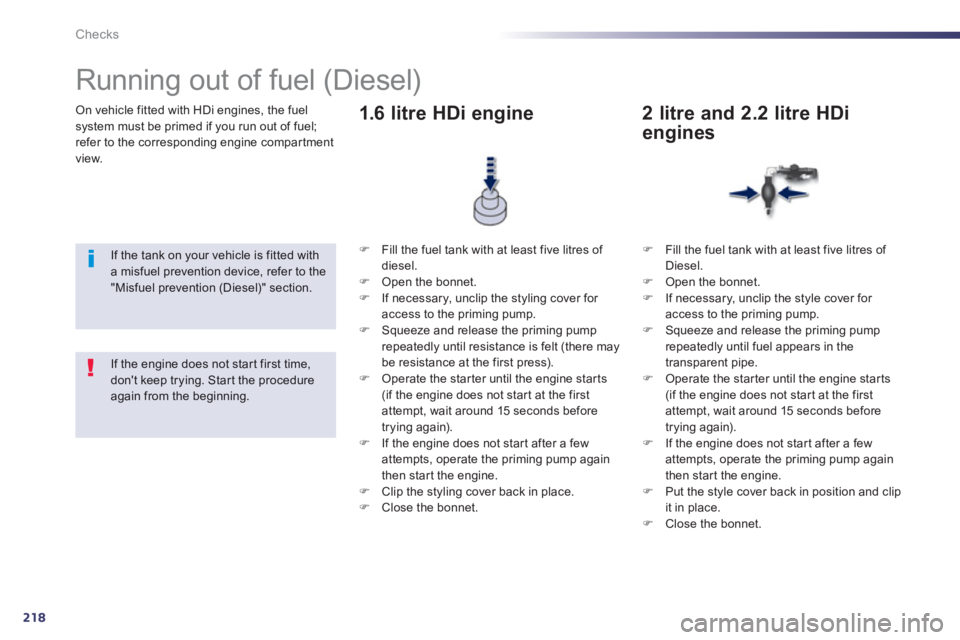
218
Checks
On vehicle fitted with HDi engines, the fuelsystem must be primed if you run out of fuel; refer to the corresponding engine compar tment
view.
Running out of fuel (Diesel)
If the tank on your vehicle is fitted witha misfuel prevention device, refer to the "Misfuel prevention (Diesel)" section.
F
Fill the fuel tank with at least five litres of diesel. F
Open the bonnet.F
If necessary, unclip the styling cover for
access to the priming pump. F Squeeze and release the priming pump
repeatedly until resistance is felt (there may
be resistance at the first press). F Operate the star ter until the engine starts(if the engine does not star t at the first
attempt, wait around 15 seconds before
trying again).
F If the engine does not star t after a few
attempts, operate the priming pump again
then start the engine. F Clip the styling cover back in place. F
Close the bonnet.
1.6 litre HDi engine
F
Fill the fuel tank with at least five litres of
Diesel.F Open the bonnet. F
If necessary, unclip the style cover for access to the priming pump. F
Squeeze and release the priming pump repeatedly until fuel appears in the
transparent pipe. F Operate the star ter until the engine star ts (if the engine does not star t at the first attempt, wait around 15 seconds before
trying again).
F If the engine does not star t after a few attempts, operate the priming pump again
then start the engine. F Put the style cover back in position and clip it in place.F
Close the bonnet.
2 litre and 2.2 litre HDi
engines
If the engine does not star t first time, don't keep trying. Star t the procedureagain from the beginning.